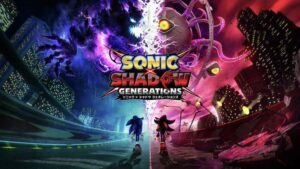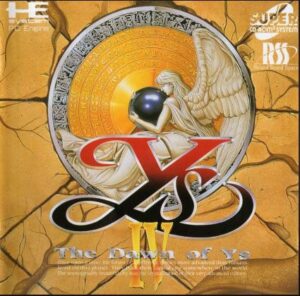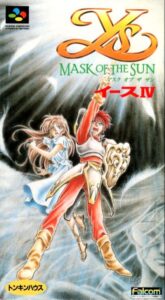Greetings all, its been a while since we talked Ys, which is strange since we are in the middle of the marathon for it. But beyond technical issues on my end, today’s game is rather unique and quite an ordeal to get through. This game is especially infamous in the Falcom community and even somewhat outside of it. Let us wait no longer before diving in! This is Wanderers from Ys!
Introduction & Pre-Production
Now, let us take step back in time to the late ‘80s; the year is 1988 and Ys II has been released. This brought a close to the original duology, building upon what worked in the original installment and making a household name of the growing Nihon Falcom. Some developers might have considered taking a break from said property, but Falcom wished to capitalize on this momentum by developing a sequel the following year. Wanderers initially saw release for PC-88 and PC-98 in 1989, with ports for various systems coming in the following years, including the Turbograf 16/PC Engine, Super Nintendo/Famicom, MSX2, and the most meme worthy version, Sega Genesis. The game also received two remakes by Falcom and Taito respectively in 2005. Most recently the PC-88 version came to the Nintendo Switch by way of Project EGG.
Some might raise an eyebrow at the fact that Falcom immediately greenlit a sequel that saw release a mere 14 months after the release of Ys II. But an important factor to note in Falcom’s career at this point was that they were producing several games a year. 1989 alone saw them release three games. In addition to Wanderers 89 they released Star Trader and Dragon Slayer: Legend of Heroes. Falcom developed a variety of games during this period with some going on to be household names for the company whilst others fading into the sands of Kefin.
Wanderers also represents one of the earlier instances of key staff lost within Falcom’s history. Both Tomoyoshi Miyazaki and Masaya Hashimoto would leave the company shortly after the development of Ys III concluded and Yuzo Koshiro an integral part of the score for previous installments of Ys would move to join them as they founded the company Quintet. Miyazaki was still the mind behind the narrative for Ys I-III whilst Hashimoto was a key part of direction, design, and programming for the same games.
Another factor to note about the era of release was that Wanderers itself was released in a time when many developers, not just Falcom, would experiment with follow up installments and not just deliver an expanded take on what worked. Similar titles that break the mold of their respective series are Fire Emblem Gaiden and Zelda 2: Legend of Link. Unfortunately, this is no Gaiden, but we’ll get there further along in this article.
Synopsis & Writing
Three years have passed since Adol’s exploits in Esteria and Ys when he and Dogi decide to pay the land of Felghana a visit. This is Dogi’s hometown, and they’ve heard tales of trouble being caused by the sudden appearance of monsters in the land. After hearing this from nearby travelers the pair waste no time travelling to Felghana. They indeed find the land under duress not only by the monsters foretold, but also from the resident lord hailing from the Romun empire Lord McGuire. He is collecting mysterious artifacts and abducting or killing anyone who interferes. Among McGuire’s knights is none other than Dogi’s childhood friend Chester who seems especially desperate to collect the artifacts. Adol’s mission is simple; collect the artifacts to prevent McGuire from getting his hands on them, find out the source of the monsters assaulting the land, and most personal, bring Chester back to the town of Redmont.
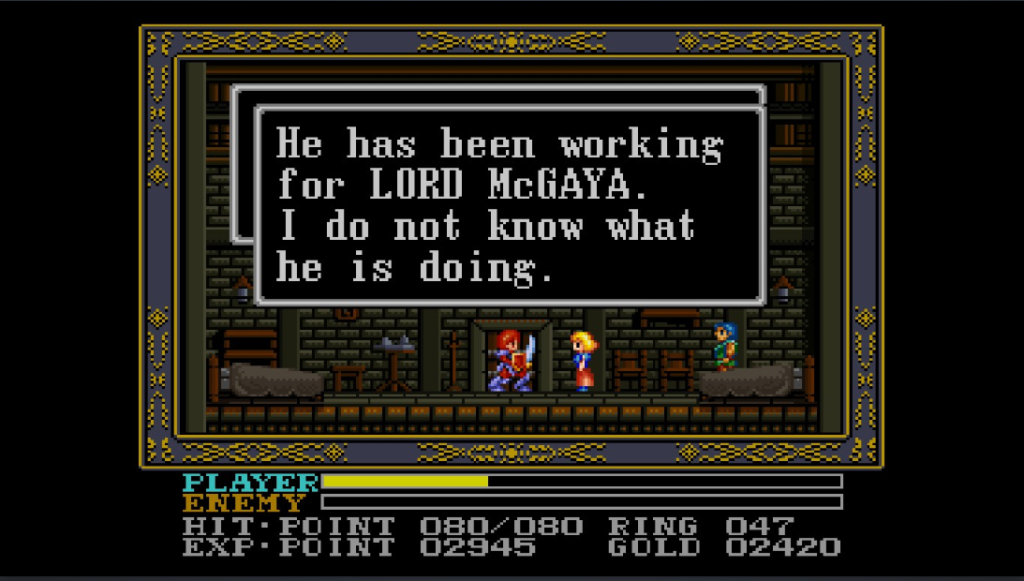
If you’ve played the remake The Oath in Felghana the broad strokes of the story are very much the same with the remake adding depth to just about every area of the story. Much of its lore was retroactively slotted into place when connected in viewing with the spiritual reboot and lore successor Ys VI: Ark of Napishtim. But here the story is exceedingly simple: collect the ancient artifacts and stop the dark lord Galbalan who rears his demonic head, just in time for the game’s climax.
One thing that the story in this game does differently than its 2005 remake is its handling of Adol as a character. The story of Ys 1 & 2 saw Adol as entirely silent until the very end when he says goodbye to Feena. This was a conscious design and character decision meant to show us how much Feena meant to Adol. But here he talks as if he was an ordinary person. He voices his thoughts on the things he does in game, the characters he comes across and much more. This is for the most part the last time that Adol would converse normally in a Falcom designed Ys game. Future installments have him returning to being mostly silent with the exception of some dialogue choices added on later in Ys’ lifecycle. I and others are of the opinion that if Adol is to speak it should add to the story in a meaningful way. But here in Wanderers it does not do that, the story is not enhanced by this decision.
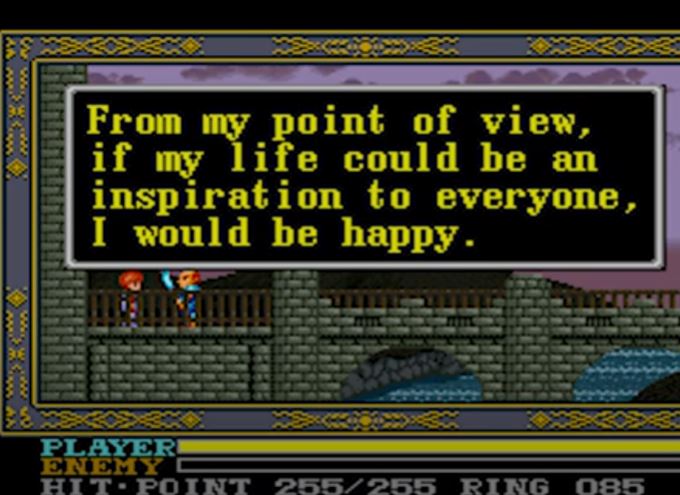
There is also no better time to talk about the timeline of Ys. As the series is presented, it is historians who recount Adol’s exploits from his travel journals. Within the meta plot of the series there are hundreds of travelogues detailing Adol’s exploits. We have not been told these stories in order though. This story is set three years after Ys II but it is not the next adventure chronologically as the events of Ys X and IV precede the events of this story.
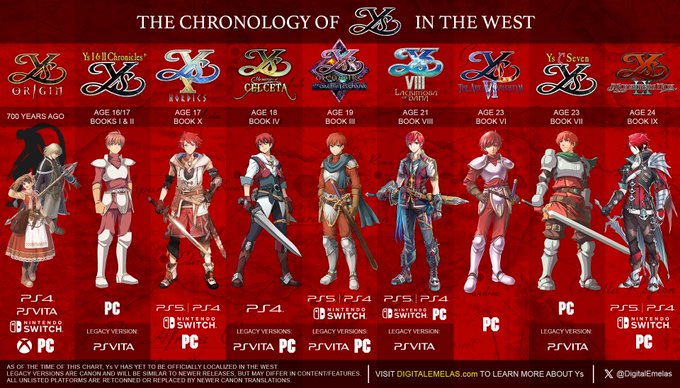
In comparison to what came before this story in Ys, as well as what will come after, it is rather simple in its execution and narrative. The remake The Oath in Felghana would expand on these ideas and flesh them out to bring this story into the modern age with a flourish. But as far Wanderers itself is concerned, the story is very barebones on its own merits, relying on material made after the fact for nearly all of its narrative weight. The story is standard for its time for its set dressing but little more. Ys I and II’s stories were also simplistic in their approach but made up for that by being thematically rich. This story in comparison lacks the same depth, and rings hollow as a result.
Gameplay
So, there were three months between when I published the piece on the original duology and this piece. It wasn’t because the story itself gave me pause, but rather because this game is exceedingly tedious to play even when it works as intended. As mentioned earlier, this game abandoned the formula of a top-down view bump-style combat in favor of a side scrolling RPG, much more akin to Sorcerian or (wincing as I say it) Zelda 2. But let’s break down this new style of play piece-by-piece.
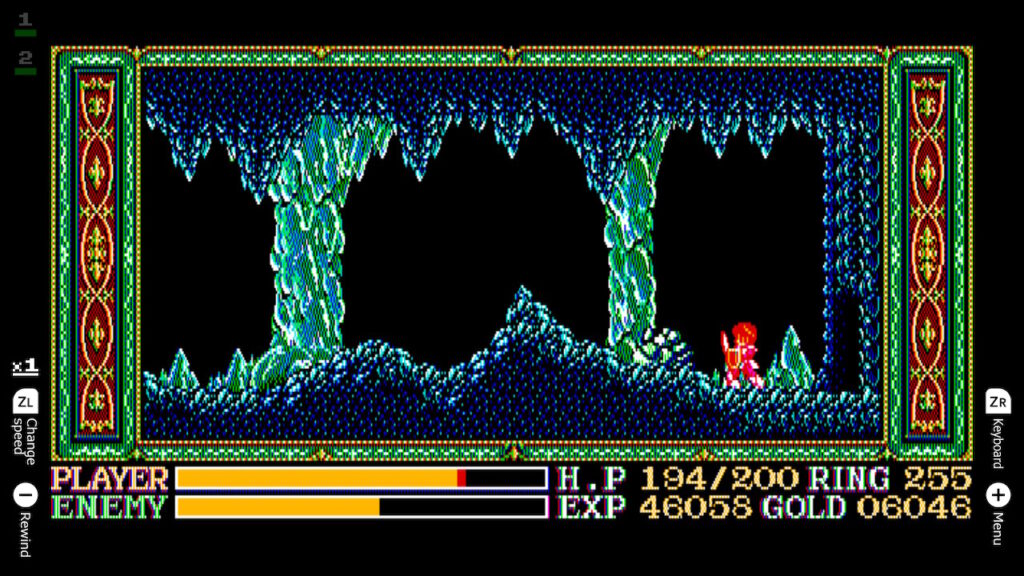
At first glance, some may be happy with this take on Ys for the fact that you actually do press a button to initiate attacks. The forced side scrolling perspective gets rid of the thing that happens when enemies get behind you in I & II when you just melt and die in a couple of seconds. Your only way through an enemy is to kill them, jump over them, or just let them move through you. And that is where the first problem arises. There are no collision physics to be found in this game. In previous games when you got hit Adol would react with you being pushed back. In Wanderers, when you hit enemies or vice versa there is no visual feedback. Combine that with no invulnerability window, which means that it is very easy for hits to rack up with you dead before you know it.
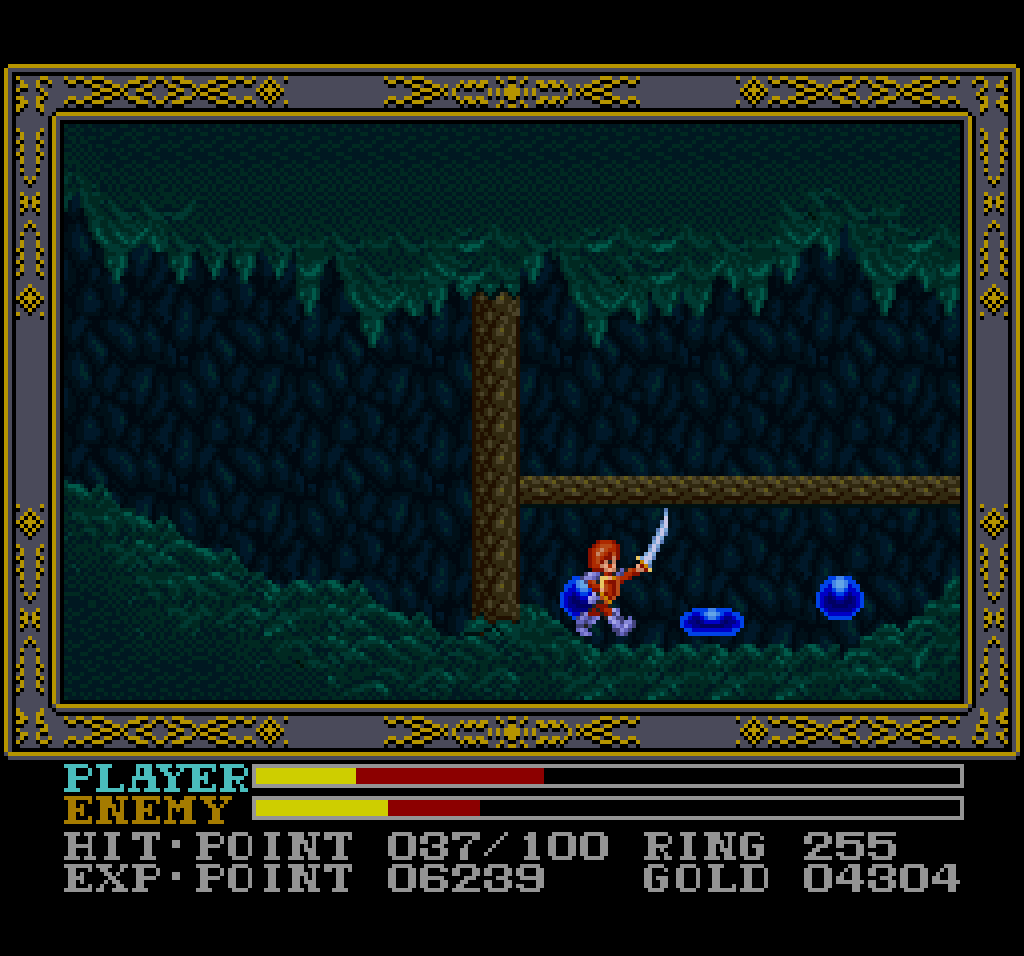
Most Falcom games make use of a scaling experience system, you’ll find it in every Kiseki game and most Ys games as well. Not here though. Scaling experience based on yours and the enemy’s level in relation to each other ensures that you wouldn’t have to grind to reach the threshold level you should have for a particular section. In fact it discourages grinding, its absence after being present in the original duology, feels like a decision to artificially extend the length of the game.
Wanderers, when pulling together its story content, is a two-hour game. But with all the grinding you’ll need to not be three-shot by any given enemy, doubles if not triples the time you’ll spend playing this. At a certain point the enemy’s damage output will outstrip your defenses even at max level. Dungeons are less a test of your skill, but rather a question of what state you are in when you reach the dungeon’s boss.
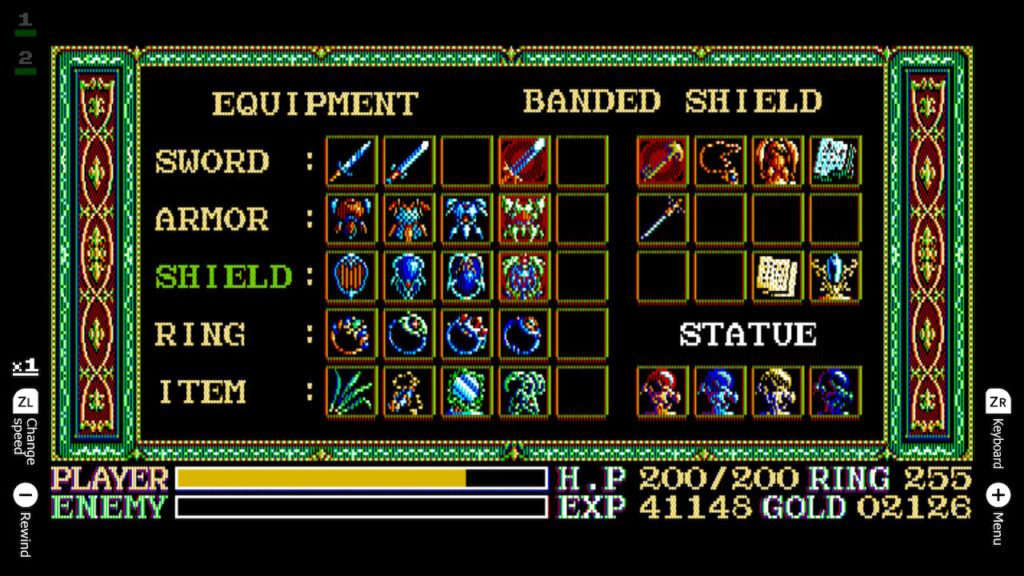
Additionally, the game features a change to the magic system. There are no spells to cast like in Ys II, but you do carry magically imbued accessories to aid Adol in his quest. These rings vary in the benefits provided, like increased damage to enemies, less damage received from enemies, slowing down enemies, and the old standby, enabling healing in dungeons by standing still. In the original duology accessories could be equipped and un-equipped at will with no penalties or costs. Wanderers flips this on its head by giving you what the game calls “Ring energy,” which starts at a value of zero. You gain magical powers by killing enemies at a rate of 1 energy per enemy or you can refill it to its maximum value of 255 for a measly 100 gold at the shop. The cost of each ring varies: the power and defense ring will drain your energy at a value of 1 per second, whilst my precious healing ring drains by 4 for every second the ring is equipped.
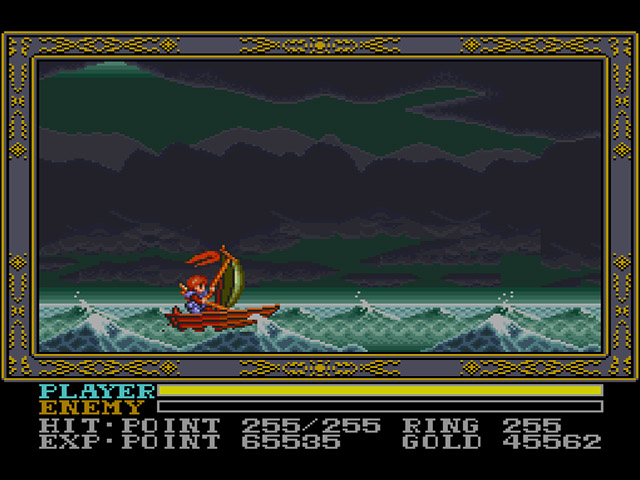
We are briefly going to talk about version differences in terms of gameplay. If possible play this on the PC-88 or PC Engine as many versions have various performance bugs that affect the moment-to-moment gameplay. The most widely available version, Super Nintendo/Famicom, is by and large the worst version as your hits often don’t register and you’ll find yourself the victim of phantom melees, being hit by foes who are a solid foot away from you.
Presentation & Score
Regardless of all the things I’ve brought up there is one thing that almost makes me forget it, almost…and that would be the music. We had some holdovers from Koshiro who had composed some tracks for this game before leaving the company. However, the other founding member of the Falcom Sound Team, Meiko Ishikawa, more than makes up for her colleague’s absence as she and the newly minted sound team serves to compose one of Ys’ best scores. Each version had their own music and accompanying composers. The score of Wanderers is widely available nowadays and is easily the most polished aspect of this entire experience.
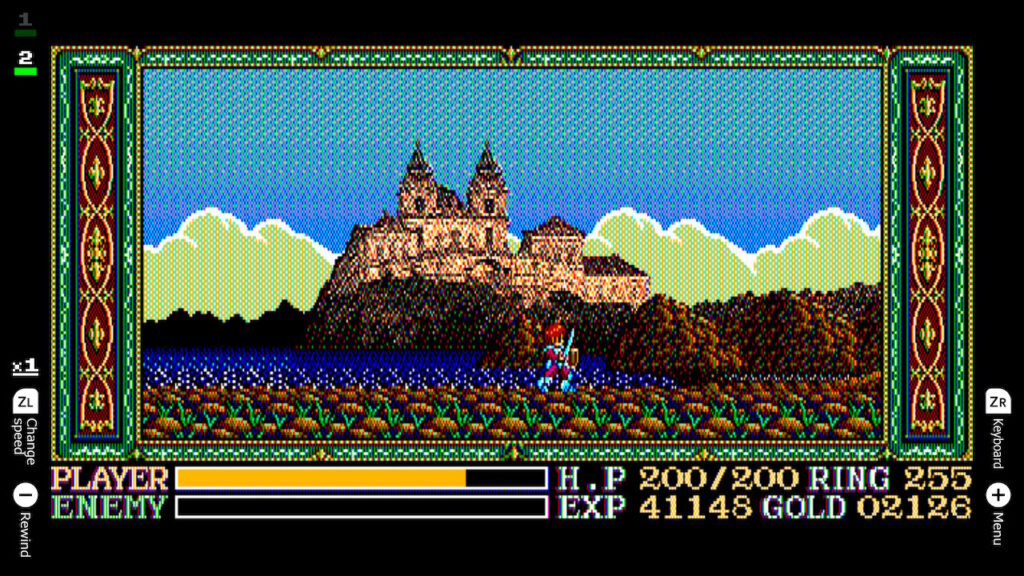
When looking at the presentation for the PC-88 versions of Ys II and III back-to-back it is quite easy to see the differences in both presentation and performance. The difference in presentation is obvious given that we went from an overhead view to a side scroller with some impressive backdrops for the time. In terms of presentation, Wanderers is a much faster game when compared to the PC-88 versions of the original duology.
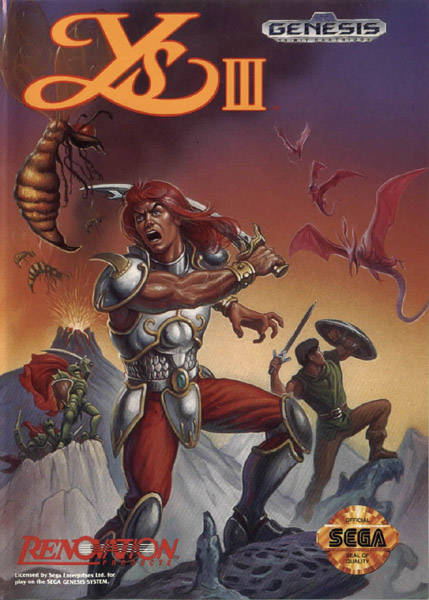
I also know my collaborator and the Falcom fanbase would never let me live it down if I didn’t mention the box art for the Genesis version of the game. Like many games of the era, the box art was changed for Wanderers to make it more “appealing” to western audiences. The Super Nintendo and Turbograf versions did this as well. But the Genesis easily set itself apart from the competition with their take on “Adol the Barbarian” and “Conan the Red” if those names strikes your fancy more. This box art has lived on internet culture for decades and Falcom themselves have also acknowledged the material with Falcom Academy an animated comedy series that puts many of the characters from all of Falcom’s properties into a whacky academia set comedy show.
Conclusion
Wanderers is a massively flawed game at its core but it still inhabits an important piece in the series history as it shows that not every idea was for the best. Experimentation in the industry is something to be admired, even if the result is a tedious, poorly designed experience. This game also did not fare well in foreign markets as it single handedly killed Ys international presence for over a decade. Western audiences wouldn’t see another Ys game until 2003’s Ys VI: Ark of Napishtim.
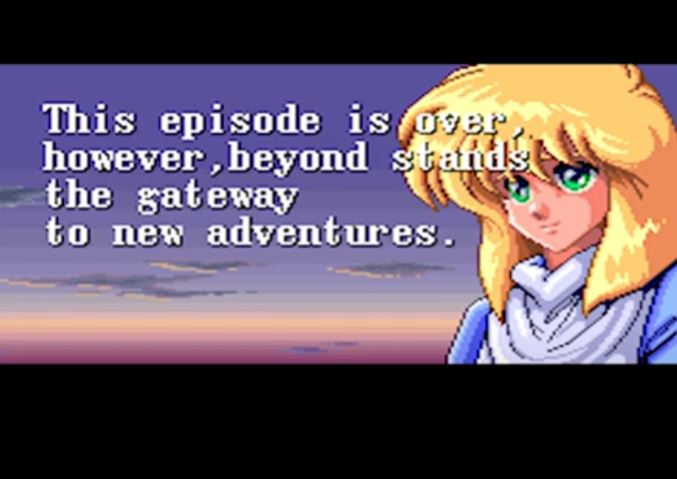
This game also forced Falcom to take a step back and truly think about what the next step should be for Ys. The next Ys game to be released wouldn’t see the light of day until 1993 and it wasn’t even made by Falcom. They themselves wouldn’t properly return to Ys until 1995’s Ys V: Sands of Kefin. I can only recommend this game to those who might be extremely curious about this experimental point in the series. As we’ll see later on there are much better alternatives for experiencing this story in the future. For everyone else I recommend staying as far away as possible. Special thanks to OmgFloofy for collaborating on this article!
Patron Shout-Out
As always I wish to thank our loyal patreon supporters who serve to make our content possible week after week. I am eternally grateful for your continued support:
Francesco
Lisa


